Protest power

Australian SPRING 2019 // ISSUE 103 $9.95 School funding // The fight for fairness continues Failing the test // Is this the end of NAPLAN? Early childhood // An uncertain future Digital custodians // Preserving Indigenous languages











FIONA FORMAN
TINA BOOGREN GAIL BOUSHEY GLEN PEARSALL
ADRIENNE GEAR
ANDREW
Like, Share, Follow @HawkerBrownlow #HBconfVIC EARLY BIRD Register before 1 March 2020 to receive early bird pricing
ANTHONY MUHAMMAD GAVIN GRIFT
FULLER
A world congress of educator unions has set out a determined agenda.
The Australian focus for the worldwide movement to combat commercial interests in education.


05 From the president

Contents SPRING 2019 // 3 ON THE COVER Australian school students are among those who have taken to the streets globally to urge leaders to take action on climate change. PHOTOGRAPHY Alamy 16 THE FUTURE OF EARLY LEARNING The federal government refuses to provide adequate funding. 18 LEARNING IS CHILD’S PLAY
focus on learning through play means stronger educational outcomes. 20 NOW OR NEVER
take to the streets to protest climate change. 24 CULTURE MATTERS
culture is embedded in all aspects of Briar Road Public School. 28 SEASONS CHANGE
A
Students
Aboriginal
continue to
and expand their skills in the second half of the year. 06 NEWS IN BRIEF • Professional development shortfall • Unions on frontline of democracy • Public school results as good or better than private schools • Fiji government condemned over union attacks 10 NEW REALITY FOR LIVING CULTURES
primary school students bring language to life using high-tech tools. 12 SCHOOL FUNDING POST-ELECTION
fight for fair funding continues. 14 THIS IS NOT A TEST!
NAPLAN heading for the great examination hall in the sky?
16 20 28 35 A MEETING OF MINDS
Our new educators
learn, grow
Aboriginal
The
Is
www.aeufederal.org.au
36
SHOULD MATTER IN EDUCATION?
WHAT
REGULARS 04 Know your union
38 Recess
Know your union
With a federal office and branches or associated bodies in every state and territory, the AEU represents more than 188,000 members industrially and professionally.
AEU FEDERAL
120 Clarendon St, Southbank, VIC, 3006
Phone: +61 3 9693 1800
Email: aeu@aeufederal.org.au
Web: aeufederal.org.au
AEU ACT BRANCH
Branch president
Angela Burroughs
Branch secretary
Glenn Fowler
40 Brisbane Avenue
Barton 2600
Phone: 02 6272 7900
Email: aeuact@aeuact.org.au
Web: aeuact.org.au
AEU VIC BRANCH
Branch president
Meredith Peace
Branch secretary
Erin Aullich
126 Trenerry Crescent
Abbotsford 3067
Phone: 03 9417 2822
Email: melbourne@aeuvic.asn.au
Web: aeuvic.asn.au
Australian Educator (ISSN: 0728-8387) is published for the Australian Education Union by Hardie Grant Media. The magazine is circulated to members of the AEU nationally.
Hardie Grant Media
Ground Level, Building 1 658 Church St, Richmond 3121
Tel: (03) 8520 6444
Fax: (03) 8520 6422
Email: educator@hardiegrant.com
Federal president
Correna Haythorpe
AEU NT BRANCH
Branch president
Jarvis Ryan
Branch secretary
Adam Lampe
3/8 Totem Road
Coconut Grove 0811
Phone: 08 8948 5399
Email: admin@aeunt.org.au
Web: aeunt.org.au
QUEENSLAND TEACHERS UNION
President
Kevin Bates
General secretary
Graham Moloney
21 Graham Street
Milton 4064
Phone: 07 3512 9000
Email: qtu@qtu.asn.au
Web: qtu.asn.au
AEU and subscription enquiries
Australian Education Union Federal Office, PO Box 1158 South Melbourne Victoria 3205
Tel: (03) 9693 1800
Fax:
(03) 9693 1805
Email: aeu@aeufederal.org.au
facebook.com/AEUfederal
@AEUfederal
Federal secretary
Susan Hopgood

AEU SA BRANCH
Branch president
Howard Spreadbury
Branch secretary
Leah York
163 Greenhill Road
Parkside 5063
Phone: 08 8172 6300
Email: aeusa@aeusa.asn.au
Web: aeusa.asn.au
NEW SOUTH WALES TEACHERS FEDERATION
President
Maurie Mulheron
General secretary
John Dixon
23-33 Mary Street
Surry Hills 2010
Phone: 02 9217 2100
Email: mail@nswtf.org.au
Web: nswtf.org.au
AEU TAS BRANCH
Branch president
Helen Richardson
Branch state manager
Roz Madsen
1/32 Patrick Street
Hobart 7000
Phone: 03 6234 9500
Email: support@aeutas.org.au
Web: aeutas.org.au
STATE SCHOOL TEACHERS UNION OF WESTERN AUSTRALIA
President
Pat Byrne
General secretary
Mary Franklyn
1 West Street West Perth 6005
Phone: 08 9210 6000
Email: contact@sstuwa.org.au
Web: sstuwa.org.au
Editor Susan Hopgood
Publisher Fiona Hardie
Account manager Hannah Louey
Managing editor Lucy Siebert

Commissioning editor Tracey Evans
Subeditor Leanne Tolra
Art director Dallas Budde
Design Natalie LaChina
Advertising manager Kerri Spillane
Tel: (03) 8520 6444
Email: kerrispillane@hardiegrant.com
Printer Ovato 42 Boorea Street Lidcombe NSW 2141
Audited circulation: 123,327
(1 October 2017 30 September 2018)
Copyright rests with the writers, the AEU and Hardie Grant Media. No part of this publication may be reproduced without the prior permission of the copyright holders. The opinions expressed in the magazine are not necessarily the official policy of the AEU.
4 // SPRING 2019
The power of education to save the planet
The 8th Education International World Congress in Bangkok highlighted the theme ‘Educators and their unions taking the lead’.
Iwas one of 1400 educations from 150 countries at Congress who came together to advance education issues globally. We have many shared issues from advancing the profession, promoting democracy to fighting for free, quality education for all, but it is clear the need to address climate change was at the front of everyone’s mind.
We heard from delegates who, like us in Australia, are already living with the impacts of climate change as a daily reality. Teachers like Neselinda Meta from Vanuatu, who spoke about being evacuated from her home and school due to the impacts of rising sea levels and the disruption this has on education, families and communities.
Educators from across the world spoke of their determination to ensure students have the facts to understand the crisis unfolding before their eyes.
Climate change is no longer about debating opinions; it is about undeniable facts.
Our students are walking out of their classrooms because they feel there is no other way to get their voice heard. They feel they don’t have a choice because their politicians have let them down. As teachers, we need to make sure we don’t let them down too.
I was moved by the words of Nobel Peace Prize laureate Kailash Satyarthi, who spoke at Congress and described teachers as “fire and light” because we “symbolise the sparks and ignition that trigger the imaginations of students”.
We are going to have to radically change the way we live, from the way we produce to the way we consume, and transition to a more sustainable economy and lifestyle. We have a vital role to play in the climate change crisis as change agents — equipping our students with the
skills to become innovators in this rapidly changing world and to speak up on issues that matter to them
With a prime minister who continues to pay lip service to climate change, we must ensure that we offer a broad and rich curriculum that addresses the issue of climate change and sustainability. So many of our students are already aware of the facts and their education is about more than just being taught the academic curriculum — it is about giving students the skills to thrive and opportunity to make a difference to society as citizens. We need to empower them with critical thinking skills, adaptability and the knowledge to engage in the political process. We need to show this is an issue that spans the curriculum from human rights to gender equality, appreciation of cultural diversity and global citizenship.
Critics, including our prime minister, say that a school student’s place should be in the classroom, and that our children should be seen and not heard. They also say students should be busy with the three R’s instead of taking an active role in the

community and campaigning for a fair and sustainable world.
Yet, we know that school students who participate in climate change protests are enhancing their education, not reducing it. Student protests are a valid form of political action, and our students absolutely have the right to participate. Under the United Nations Convention on the Rights of the Child, all children have the right to express their views freely on all matters that affect them.
Personally, I see the student strikes as a great source of hope. Our students are proving they do not lack the will or the courage to step up and demand a better future for the planet.
However, as much as we want to support them in their campaign, it inevitably comes back to funding. Teachers need the support, time and resources to be able to integrate climate change into their teaching and learning activities. That requires a meaningful investment in education. Unfortunately, we have a federal government that is cutting public school funding and refusing to meet the needs of every child.
Before leaving Congress, delegates endorsed a resolution that highlights the role of education in resolving the climate crisis and defines climate change as one of the key priorities of Education International for the next four years.
The aim until the 9th World Congress is nothing less than to ‘Change the world’. With the right investment in student education, we can. We must. To quote one of the student protest signs: ‘there is no education on a dead planet’.
SPRING 2019 // 5 From the president
Correna Haythorpe AEU federal president
Our students … feel they don’t have a choice because their politicians have let them down.
News in brief
Susan Hopgood re-elected president of Education International
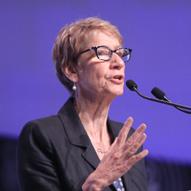
Education International’s 8th World Congress was held in Thailand in July and brought together national education unions of 150 countries representing 32.5 million educators and support staff.
AEU federal secretary, Susan Hopgood was re-elected as president for a further four years to a standing ovation from the Congress floor.
Education is missing global targets
One in six children around the globe still won’t be in school by 2030, despite a five-year-old United Nations target.
The Sustainable Development Goals (SDGs), adopted by the UN in 2012, were due to be achieved within the next decade. But SDG 4, which aims to ensure inclusive and equitable quality education and to promote lifelong learning for all, is unlikely to be met without “serious progress” from now, according to UNESCO. At current trends, learning rates are expected to stagnate in middleincome countries and drop by almost one third in Francophone African countries in 2030. An estimated 20 per cent of young people and 30 per cent of adults in low-income countries will still be unable to read by the target date for the elimination of illiteracy.
Study finds PD shortfall
Australian teachers value professional development but say training in some areas is still lacking.
More than 90 per cent of Australian teachers agree that professional development has a positive effect on their teaching practice, according to the Organisation for Economic Co-operation and Development’s (OECD) Teaching and Learning International Survey (TALIS) 2018. But the survey reveals more could be done.
Australian teachers regarded initial teacher education and induction processes as leaving them feeling unprepared for the classroom, while access to professional development was limited by excessive workload and inflexible schedules.
The TALIS survey revealed 18 per cent of principals reported that delivery of quality teaching was hindered by a shortage of teachers with the necessary skills to teach students with special needs.
It also found that only 78 per cent of class time was dedicated to teaching and learning and the remainder was spent on managing behaviour and completing administrative tasks.
Unions on the frontlines
Unions have a big role to play in the fight for democracy, a new social contract and climate change, says International Trade Union Confederation general secretary Sharan Burrow.
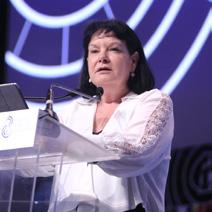
“Unions are on the frontlines because we share a set of values,” she told Education International’s 8th World Congress in Bangkok.
“We stand for hope, not hatred; rights, not oppression; democracy, not dictatorship; freedom, not fascism; solidarity, not division; trust, not despair; fairness, not inequality; courage, not fear. We stand for the 99 per cent not 1 per cent; dignity, not exploitation.”
Service recognised
Burrow was this year named a Companion of the Order of Australia for eminent service to industrial relations at the national and international level and social equity, and as a champion of human rights in developing countries.
She joined the union movement after becoming a teacher at a NSW public
school in the 1980s, was elected AEU president in 1992 and ACTU president in 2000. She became the first female general secretary of the International Trade Union Congress in 2006.
The AEU congratulates Burrow and says the honour is a well-deserved recognition of her lifelong dedication and passion for education, trade unions, social justice and equity for all.
6 // SPRING 2019
News
ILLUSTRATION OSLO DAVIS
Public school results as good or better
A Victorian study has found public schools equal or outperform private schools with similar ICSEA (Index of Community SocioEducational Advantage) rankings.
Southern Cross University compared the results of 229 private and 278 public schools. The study, reported in The Conversation, excluded schools with fewer than 20 students at Year 12 and select-entry public schools. It compared VCE results and school-based data, including funding details available from
MySchool and individual school websites between 2014 and 2018.
Adjunct associate professor David Zyngier says that in Year 12, private schools on average outspend public schools by almost $8000 per student to achieve a similar result.
✔
The average Year 12 fee in public schools is $753 compared to $12,374 in private schools.
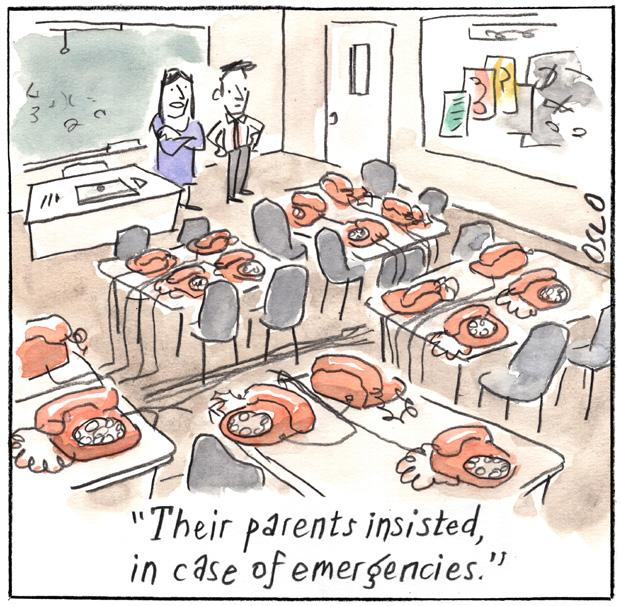
“Can we imagine how much better our public schools could be with the extra resources that would be available if governments transferred the $13.7 billion spent on private schools to their public counterparts?” Zyngier says.
LESSONS ON DEMOCRACY
Teachers working at all levels in the education system contribute to strengthening and protecting democracy, helping students to become active citizens able to make wise choices, according to a new book.
On Education & Democracy: 25 Lessons from the Teaching Profession is authored by AEU federal secretary and Education International president Susan Hopgood and former Education International general secretary Fred van Leeuwen.
The lessons serve as a set of recommendations to every classroom teacher working at all levels in our education system and in their education unions, write Hopgood and van Leeuwen.
“We believe the real safeguard of democracy is education and the ability of our schools and universities to fulfil that role will largely depend on the teaching profession. We know that educators around the world, whether they work in democratic, non-democratic or authoritarian environments, are ready to play their part.”
On Education & Democracy: 25 Lessons from the Teaching Profession can be downloaded free at tinyurl.com/y44qrngl

SPRING 2019 // 7
ON THE MOBILE PHONE BAN…
Technology • Environment • Pedagogy • Curriculum Australia’s most important professional development “Festival of Ideas” for K-12 educators and partners 7th Annual SPONSORSHIP + EXHIBITION OPPORTUNITIES STILL AVAILABLE APPLY NOW education@terrapinn.com 18 + 19 March 2020 Melbourne Convention + Exhibition Centre www.futureschools.com.au 110+ LEARNING HOURS 180+ SPEAKERS 150+ PARTNERS ALL-IN-ONE DELEGATE PASS = REGISTER NOW @ WWW.FUTURESCHOOLS.COM.AU FOR SUPER EARLY BIRD SAVINGS - USE CODE: AEEB* *Ends 4th October 2019 / Group discounts apply Professional Development Re-Imagined
Fiji govt condemned over union attacks
Teachers and other civil service workers in Fiji are being threatened and arrested over their links to trade unions.
Fiji unions, backed by high-profile international organisations, are standing their ground against attempts by the Bainimarama government to suppress their activities.
The International Trade Union Confederation, the Australian Council of Trade Unions, the International Labour Organisation (ILO), the New Zealand Council of Trade Unions and Amnesty International have condemned the Fiji government’s arrest of union leaders, and the ACTU has called on prime minister Scott Morrison to intervene
The general secretaries of the Fiji Trades Union Congress (FTUC), the Fiji Nursing Association and the Fiji Teachers Association have all been arrested and detained for several days. In May, more than 20 workers were arrested during protests over sackings by the Water Authority.
The FTUC’s Felix Anthony has been arrested twice: once during a meeting with the government and the ILO and again after he was quoted in New Zealand media.
STRIKES OUTLAWED
The government has put in place new rules for all civil service workers, including declaring their work as essential services, which denies them the right to strike or protest without permission.
Teachers have copped the brunt of the new rules. Among sweeping changes introduced by the education ministry are
contract terms ranging from six months to five years. Under the contracts, teachers can be sacked without cause.
It has left teachers feeling threatened and demoralised, says Council of Pacific Education general secretary Govind Singh.
“They’re looking for any chance to leave the profession. I mean, where is the evidence that you’ll improve efficiency by putting a teacher on a six-month contract? Who would want to do that?”
The Fiji Teachers Union (FTU) has applied for permission to poll members on strike action but each time it was refused. When eventually the union decided to go ahead with a vote anyway, the education ministry sent a circular to every school warning teachers not to participate in an “illegal” exercise and threatened disciplinary action.
The union has lodged High Court action against the ministry after a second threatening ministry circular to all teachers, which followed a union newsletter publicising a proposed FTUC march and rally. Teachers were directed not to participate in any union protests, even outside school hours.
RIGHTS TRASHED
The government is trying to trash workers’ rights and instil fear, says FTU general secretary Agni Deo Singh.
“I fail to understand why a government that barely won the recent election continues to ride roughshod over the people, especially the workers.
Agni Deo Singh
secretary
“All we are saying is ‘please come to the table and let us negotiate’. We want to have well-motivated, well-remunerated teachers who have a happy and safe working environment and security of tenure,” Singh says.
Singh says the government is violating a 2015 agreement it signed with the ILO to restore workers’ rights.
SPRING 2019 // 9 News
FTU general
All we are saying is ‘please come to the table and let us negotiate’. We want to have well-motivated, well-remunerated teachers who have a happy and safe working environment and security of tenure.
New reality for living cultures
A group of Aboriginal primary school students is bringing culture and language to life using high-tech tools.
An app, Indigital Storytelling, brought sound and imagery together as an augmented reality picture on a phone, merging the digital and physical worlds. Holding a phone over a starfish or goanna drawing produces a 3D image of the associated word with
FOCUS ON INDIGENOUS LANGUAGES
The United Nations General Assembly has declared 2019 the International Year of Indigenous Languages to raise awareness of the crucial role languages play in people’s daily lives.
The Njulgang Digital Custodians Project uses augmented reality, the same technology that powers the once-popular Pokémon GO app, to engage and teach students.
A group of Dharawal Elders is working with 20 Aboriginal and Torres Strait Islander students from five primary schools in south-western Sydney on the project, which is run by the New South Wales Department of Education and the Aboriginal Education and Communities Directorate.
They’ve used technology to create a language-learning resource based on the Dharawal Dreaming Story – How the Animals Came to Dharawal Country. Njulgang means “We All” in the Dharawal language.
The aim of the project is to equip students with the digital skills they need
to learn and preserve their language. Knowledge of Indigenous languages is considered central to maintaining strong cultural connections.
Participants were assisted by the Eastern Zone Gujaga Aboriginal Corporation and Indigenous technology company Indigital to find the right technology to capture, create and bring life to the Dreaming story.
As well as sharing the Dreaming story with Year 5 and 6 students, the Dharawal Elders taught them vocabulary and pronunciation. Then it was time to create the characters, including a goanna, starfish and whale.
The students used Microsoft Paint software to draw 3D images of the animals, and Minecraft to design the scenes for the story. Narration was voiced by the students in both English and Dharawal.
In Australia, of the estimated original 250 Aboriginal and Torres Strait Islander languages, only about 120 are still spoken. Of these, the Department of Communication and the Arts says approximately 90 per cent are endangered.
The UN says languages are at the heart of identity, cultural history and memory: “The ongoing loss of indigenous languages is particularly devastating as the complex knowledges and cultures they foster are increasingly being recognised as strategic resources for good governance peacebuilding, reconciliation, and sustainable development.”
The AEU is working in partnership with First Languages Australia to encourage schools to get involved in the Indigenous Year of Languages – firstlanguages.org.au
You can find classroom resources at tinyurl.com/y2o9ykan

10 // WINTER 2019
Aboriginal and Torres Strait Islander peoples
PHOTOGRAPHY COURTESY INDIGITAL STORYTELLING; i STOCKPHOTO.COM
a recording of its pronunciation in Dharawal and English.
Stuart Keast, deputy principal at Rosemeadow Public School, says participation in the project — and the app itself — is about “cultural sustainability”.
“Writing down these Indigenous stories is a way for students to learn about and maintain their Indigenous culture and history,” he says.
The technology allowed Elders and students to collaborate even when they couldn’t meet face to face. Keast says

that one of the Elders, Uncle Ray, sent the school a sound file of 200 words.
“This meant the students could listen to the words whenever they wanted to and practise the correct pronunciations.”
An added benefit of the project was improved attendance and student self-assurance. The students started out shy, says Keast, but as they got to know the Elders, and worked with software developers, their self-belief and confidence grew.
Children’s Hearing Check Screening Solution

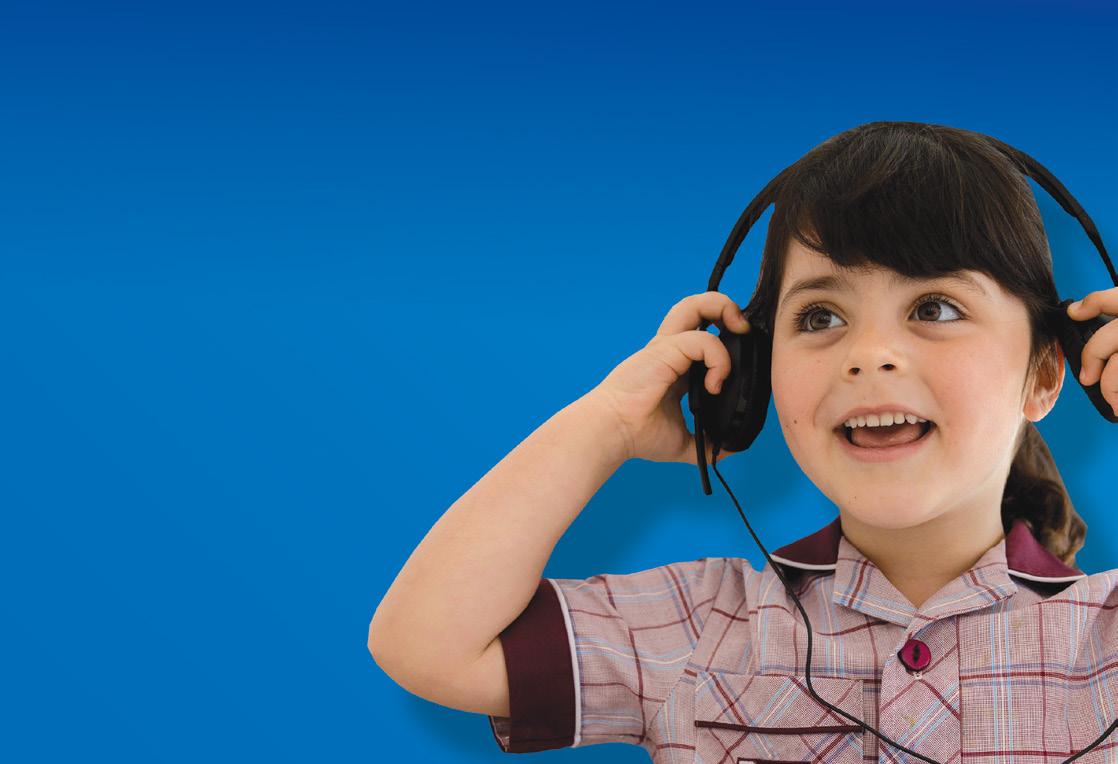
Test your students’ hearing for FREE
Even students who didn’t take part in the project gained a greater appreciation of the Dharawal language and culture, says Keast.
The participating schools include Briar Road Public School, Bradbury Public School, Campbelltown East Public School, Rosemeadow Public School and Thomas Acres Public School.
soundscouts.com.au


The aim of the project is to equip students with the digital skills they need to learn and preserve their language.
“The money isn’t going where it’s needed.”
Don’t pack away the green T-shirt — the fight for fair funding continues.

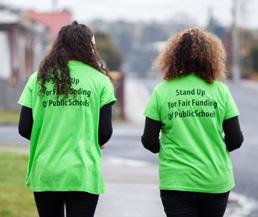

It was hoped May 18 would have delivered proper funding for public schools. Instead, after the results of the federal election, the fight for justice for Australia’s public schools must enter a new phase.
“Our campaign has not changed. Our goal for fair funding for public schools has not been achieved and we will keep fighting until it has,” says AEU federal president Correna Haythorpe.
Within a month of the the Coalition’s federal election win, Victoria reluctantly became the last state to sign up to the federal government’s National School Reform Agreement — a joint agreement between the Commonwealth, states and territories that ties school funding to the Morrison government’s reform agenda until 2023.
The bilateral agreements between the Commonwealth and each state and territory set out their specific reform actions and funding contributions. AEU analysis of the agreements reveals that Australia will continue to experience unprecedented levels of inequality between public and private schools due to great disparities in Commonwealth funding contributions for these sectors.
Under the current funding arrangements, the Commonwealth government has legislated to fund public schools to only 20 per cent of the Schooling Resource Standard (SRS) while providing 80 per cent of the SRS for private schools. The SRS was a key recommendation of the independent Gonski Review and sets
IN SHORT
// Most private schools are funded at 100 per cent of the Schooling Resource Standard (SRS).
// Ninety nine per cent of public schools will not get the full SRS.
// There is a widening disparity in capital spending between private and public schools.
out the minimum fair funding level for students in schools in each sector — Public, Catholic and Independent. It is made up of a base amount for every primary and secondary student, with a loading to provide extra funding for students with higher needs.
Most private schools are funded at or above 100 per cent of their SRS, while public schools everywhere, except the ACT, will be demonstrably underfunded in 2023.
12 // SPRING 2019
The AEU is committed to ensuring public schools receive their fair share of funding.
In fact, 99 per cent of public schools in Australia will not reach the full SRS [see table].
That’s a projected underfunding for public schools of more than $22.7 billion by 2023.
PRIVATE SCHOOLS GUARANTEED FUNDS
Meanwhile, the $4.6 billion deal for private schools announced by the federal government last year will ensure that overfunded Catholic and Independent schools maintain their Commonwealth funding of 80 per cent of the SRS until at least 2029.
“We have a Coalition government that says it’s OK for public schools to be underfunded, creating a two-tier structure in education and providing far more resources to one tier of education,” Haythorpe says.
AEU analysis of My School data released before the election revealed the scale of inequality in Victoria, where many Catholic schools received more state and federal funding per student than nearby public schools, before private income such as fees was included.
In the La Trobe electorate, the gap was more than $1300 per student.
Victoria was left with little choice but to sign up to the Coalition’s inequitable funding system, but the AEU Victorian branch remains determined to pursue funding justice.
Deputy president Justin Mullaly says there is an “astounding” lack of transparency about how the funding deal between state and federal governments will deliver funding into public schools.
“Neither the federal nor state governments want principals,
How public schools are underfunded
The national school resource standard (SRS) is a standard which determines the minimum total public funding required to educate each student. The table (below) shows that public schools in all states and territories, except the ACT, will not reach 100 per cent of the SRS over the next five years.
AEU federal president
“Across Australia, the need for capital investment in public schools is evident with growing enrolments and a backlog of maintenance and new infrastructure needed. Yet the federal government is giving $1.9 billion to the private sector for capital works, but has not done the same for public schools,” Haythorpe says.
The lack of Commonwealth capital funding for public schools occurs despite the fact ABS data shows almost 200,000 additional students have enrolled in Australian schools in the past five years and 76 per cent of the growth has been in public schools.
teachers, or parents to be able to do the numbers on the extent that public schools will be underfunded,” he says.
“It’s impossible to tell where the funding is going, except that it is clear every Catholic and independent school will reach or exceed the minimum funding benchmark and public schools won’t.”
DISPARITY IN CAPITAL SPENDING
Compounding this is a widening inequality in capital spending. The Coalition lavished capital funding on private schools before the election.
My School data shows in 2017 in NSW, capital works spending on independent schools was five times higher than public schools. In Victoria it was three-and-a-half times higher.
Between 2015 and 2018 the number of students in public schools increased by 113,039 compared to an increase in Catholic school enrolments of 196 and an increase of 29,626 in Independent schools. Catholic school enrolments decreased in 2017 and 2018.
In the lead up to the election, the Morrison government announced a Local Schools Community Fund.
“While public schools might get a one-off payment worth a few thousand dollars from this fund, more than three hundred private schools have been allocated substantial capital grants worth an average of $1 million each over the past two years, which is nothing less than insulting to the sector with the greatest need.
“It’s not about the politics of envy. It’s about the politics of equity,” Haythorpe says. “The money is not going where it’s needed.”
The AEU is preparing the next steps in its fair funding fight. Watch this space.
Agenda: School funding SPRING 2019 // 13
Correna Haythorpe
It’s not about the politics of envy. It’s about the politics of equity. The money is not going where it’s needed.
PHOTOGRAPHY ISTOCKPHOTO.COM 2019 2020 2021 2022 2023 % % % % % ACT 107.5 106.1 104.8 103.3 100.0 NSW 89.1 88.8 90.6 91.4 92.2 NT 79.1 79.7 80.3 80.4 79.0 SA 92.3 93.0 93.7 94.3 95.0 TAS 92.6 93.0 93.3 93.8 94.1 WA 96.8 94.7 93.6 94.0 95.0 QLD 87.8 88.2 88.5 88.9 89.3 VIC 85.8 86.7 87.9 89.1 90.4 Source: National School Reform Agreements
This is not a test!
Is NAPLAN heading for the great examination hall in the sky?
After the repeated debacle of the NAPLAN Online trial in May it’s hard to believe it can survive.
Academics have denounced the testing regime’s flaws; Australia’s three largest states have conducted their own comprehensive review; and AEU federal president Correna Haythorpe says it’s a matter of when, not if, NAPLAN goes.
The Coalition’s federal election victory may have given the 10-year-old program a lifeline, but the voices defending it have almost disappeared.
Some 30,000 students had to resit the online test in May because of network, software or hardware problems, exposing both technical flaws in the rollout and deep inequalities in infrastructure between schools and sectors.
Many students resat the test on paper, making result comparisons unreliable for a second year.
Haythorpe says many AEU members reported that students were distressed by the problems — underlining again that the supposedly diagnostic test has become high stakes for students, teachers and schools.
A POOR MEASURE
The Gonski Institute at the University of New South Wales is the latest academic body to voice deep criticism of the program. As a former NSW education minister, its director, Adrian Piccoli, knows the distorting pressures that NAPLAN brings.
“The ‘measure’ of an education system and how it’s going, and therefore how the government is going, is NAPLAN results — and it’s a very, very poor measure,” Piccoli told Australian Educator.
“Governments want to see their NAPLAN results improve but that doesn’t necessarily mean you’re improving education.
“That’s the problem with any kind of performance measure — you start concentrating on how you get the numbers up, and you start missing out on things like music and creativity because they’re not counted.
“The thing has been around for 10 years,” he says. “I don’t
NAPLAN has drawn criticism from many leading academics – even before about 30,000 students had to resit the NAPLAN Online test earlier this year.
think anybody can really say that nationally it’s improved Australia’s education performance … (Many) would argue it’s made Australian education worse.”
Professor Jim Tognolini, director of educational measurement and assessment at the University of Sydney, echoes Piccoli’s views. He says the publication of results on the My School website distorts the data.
“When NAPLAN was built, its purpose was to give feedback on one occasion, in the context of all other information,” he said in May. “Now, schools are advertising themselves and selecting students based on NAPLAN results.
14 // SPRING 2019
“Because of this, NAPLAN has lost credibility,” Tognolini says.
FAILING ON ALL FRONTS
Since NAPLAN’s inception, academics have warned against assigning scores to students — and by extension institutions and systems — on the basis of such a slight test with a significant margin of error.
“One test at the moment is trying to report to parents, trying to be diagnostic, trying to inform teachers and also report on the system and inform where funding gets allocated, and the effectiveness of interventions, and it’s just not designed to do all those things,” Piccoli says.
Indeed, NAPLAN arguably fails on all fronts. Canberra parent Trina Cleary says: “I know that I can learn more from a five-minute conversation with my child’s teachers than from their NAPLAN results, and teachers are infinitely more capable of the ongoing, individualised assessment that my child needs.”
IN SHORT
// Network, software and hardware issues have plagued NAPLAN Online.
// Diagnostic tests can trigger distress in students.
// Standardised testing, such as NAPLAN, has been widely criticised by academics.
The stress and even trauma that students experience as the stakes get higher undermines the present focus on children’s wellbeing and mental health, Cleary says. “I’ve never experienced NAPLAN results being used for anything useful.”
The Gonski Institute argues for a switch to sample testing for system-wide analysis of education performance, leaving teachers to conduct genuine diagnostic assessment of their students that supported teaching and learning.
That appears to be the global trend, as countries around the world turn their back on standardised testing. Andy Hargreaves, research professor at Boston College in the US, said during a visit to Australia earlier this year: “The age of highstakes testing is on its last legs.”
UNINTENDED CONSEQUENCES
Countries that introduced such regimes in the 1990s had since woken up to the unintended consequences: teaching to the test narrowed curriculums, stressed students and created a reluctance among educators to innovate.
Successful education systems are turning their backs on standardised testing. Singapore no longer runs system-wide tests on children under 11 and Finland has moved to sample testing. Haythorpe says it’s time Australia followed suit.
“We’re very quick to take up other countries’ worst practice. It’s time we started to take up their best practice,” Haythorpe says.
Details of the comprehensive review to be undertaken by NSW,
Victoria and Queensland were still awaited as Australian Educator went to press. Minister for Education
Dan Tehan has called the review “premature”, while narrower reviews into the problems with NAPLAN Online and the presentation of results on My School are ongoing.
In September, state, territory and federal ministers will discuss the presentation of this year’s results on My School given the problems with the online test, which was sat by about half of all tested students.
They agreed in June to take an extra year to get NAPLAN Online right, pushing back the complete roll-out from next year to 2021. That, says Haythorpe, is a pointless exercise. “It isn’t dealing with the real issue. Why put a badly designed assessment process online when it’s not the way forward?
“We can’t have any more tinkering — NAPLAN is fundamentally broken. Nothing is going to fix it.”
SPRING 2019 // 15 Agenda: NAPLAN
IMAGES ISTOCKPHOTO.COM
We’re very quick to take up other countries’ worst practice. It’s time we started to take up their best practice.
Correna Haythorpe
AEU federal president
What’s the future for early learning?
Early childhood education benefits the child and, ultimately, the economy. Yet the federal government refuses to provide adequate funding.
The evidence is well established to support the provision of two years of quality early childhood education. We know that children have better learning outcomes and develop their skills in other areas such as social, behaviour and language acquisition, and this is backed up by a raft of local and international studies.
Studies that investigate the economic benefits of early childhood education show better returns for the country.
A recent report, A Smart Investment for a Smarter Australia, commissioned by The Front Project, estimates a two-for-one return on investment in quality early childhood education. The result would be higher tax revenues,

higher wages and productivity, and lower spending on welfare and criminal justice.
Even federal treasurer Josh Frydenberg acknowledges “a quality preschool education is essential for laying the foundations for successful learning, including transition to full-time school and future school success”. But his actions don’t back up his words.
16 // SPRING 2019
When the treasurer handed down this year’s Federal Budget, he again announced funding for just 12 months of early childhood education, and then only for fouryear-olds. This means preschools and kindergartens only have funding until the end of next year
EDUCATORS AND PARENTS FURIOUS
Early childhood educators and parents are furious and frustrated.
Director at Box Hill North Primary School Kindergarten in Melbourne Danielle Cogley says the continued short-term funding allocations are a big problem. “It’s really frustrating not be able to plan for the long term and not having the security of funding,” she says.
“I don’t know what I can offer families in a year or two years’ time. I don’t know what hours I can offer my staff, or what I’ll be working.
“We’ve campaigned for years trying to get just that little bit more and these band-aids of one more year of funding are really just appalling,” Cogley says.
IN SHORT
// Funding for preschools and kindergartens is only secured until the end of 2020.
// Australia does not currently fund three-year-old preschool.
// Early childhood educators face uncertainty and lack of stability in the sector.
15 hrs
Mitchell Institute researcher Jen Jackson can point to one of the effects of the insecure funding on the sector. She says that National Workforce Census data shows the proportion of educators leaving preschools due to short-term contracts is nearly four times the proportion in long day-care centres.
“That’s really saying that there’s something going on with preschool that’s affecting stability,” she says.
AEU federal president Correna Haythorpe agrees, saying that ongoing, permanent employment is a top priority for educators.
“But when you’ve got a sector that has its funding at risk every single year, it’s very difficult to attract and retain preschool teachers and support staff into the profession,” says Haythorpe.
Jackson says that affects the children, too.
“We know that stable continuous relationships are the foundation of quality practice in early childhood.” In other words, she says, high staff turnover affects quality.
“Quality relationships aren’t just about warm, fuzzy care, they’re actually fundamental to what children need for learning,” she says.
LONG-TERM BENEFITS EASY TO SEE
Cogley’s 10 years at Box Hill North have shown her the benefits of early childhood education as her students go onto primary school.
She notices their willingness to learn and explore, their resilience and their self-confidence.
“We see a big difference in the children we’ve had here for two years, who’ve done three-year old and four-year old kinder, and how well they do as they move through the system. Their teachers comment on it, too,” she says.
On Cogley’s wishlist is 15 hours of preschool for both three- and four-year-olds.
“The amount of foundational learning that those children would be able to do in those two years would be absolutely phenomenal and set them up to absolutely thrive throughout their schooling — socially, emotionally, in all facets of their education,” she says.
Jackson says the ideal is removing cost as a barrier to families accessing quality early childhood education.
“We’ve got increasing participation but we’ve also got increasing equity gaps in the quality of what those children are receiving. And we actually need the highest quality services for the children and families that need them the most,” says Jackson.
Not only is the federal government’s education agenda a fail for both students and educators, it puts us out of step internationally. Most of the 36 Organisation for Economic Co-operation and Development countries provide preschool for three-year-olds.
Australia keeps company on the list of 11 that don’t. These include Algeria, Angola, Bermuda, Gibraltar, Iran, Ireland, Nigeria, the Philippines, South Africa and Sri Lanka.
SPRING 2019 // 17
Agenda: Early childhood education
Research shows the benefits of 15 hours of preschool for both three- and four-yearolds.
Corenna Haythorpe
AEU federal president
When you’ve got a sector that has its funding at risk every single year, it’s very difficult to attract and retain preschool teachers and support staff.
Learning is child’s play
A focus on learning through play is the pathway to happier children and stronger educational outcomes.
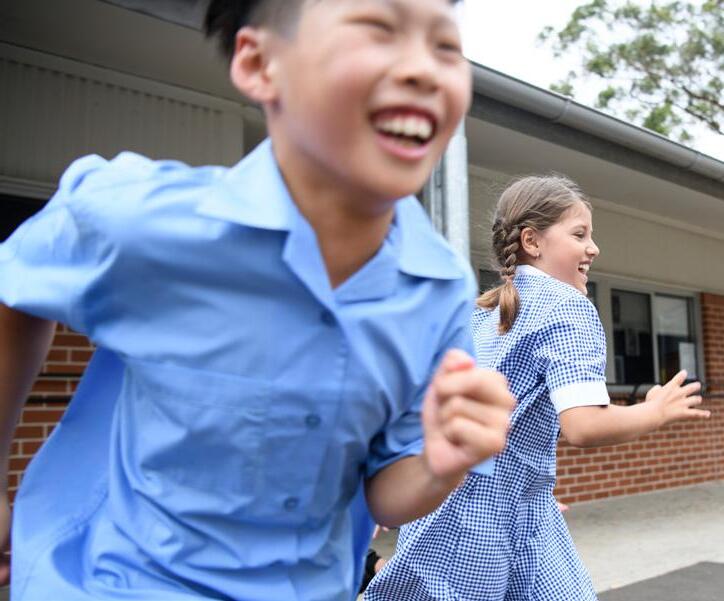 BY KRISTA MOGENSEN
BY KRISTA MOGENSEN
While living in the United States, Finnish educationalist
Dr Pasi Sahlberg was surprised when a colleague suggested that his then two-year old child’s behaviour showed signs of Attention Deficit Hyperactivity Disorder (ADHD). “We don’t call it that in Finland,” says Sahlberg. “We call it childhood.
“The work of childhood is ‘play’,” he says. In Finland, this translates as outdoor, unstructured play, staying close to nature and avoiding screens. All preschool and early years schooling is play-based, aiming to teach children: What is learning and why do we need to do that?
Formal schooling begins at age seven and children play outdoors for 15 minutes after each 45 minutes of class, no matter the weather, throughout their primary years. School days are shorter, too.
“The first year of primary school in Finland is still a very soft landing,” says Sahlberg. “It’s much more about helping children understand why they go to school.” As a result, most Finnish children take responsibility for their own learning in school, he says. “They learn that education is something you do for yourself, so that you make the best out of your own life.”
EVIDENCE UNCOVERED
In his new book Let the Children Play, authored with William Doyle, the pair criticise a “global education reform movement”, or GERM, that pushes policies of early learning
and testing into schools, and has the unintended consequence of depriving children of play.
“There is no evidence that earlier academic instruction and learning has any benefits for children,” says Sahlberg.
But he says there is overwhelming evidence about the importance of play. “That’s one of the single most important findings we made during our research.” Paediatricians around the world, and particularly in the
In Finland, children only start school at aged seven and spend at least 15 minutes outside after every 45 minutes of class.
US, are hugely concerned about children’s deteriorating physical and mental health.
“Play is the prevention of many of the problematic symptoms we see now in our children and a remedy for stress, depression and anxiety, which are often made worse by school,” he says.
Sahlberg does not directly link the loss of play with the epidemic of ADHD diagnoses. “I think it is more complicated than that,” he says. “But
18 // SPRING 2019
IN SHORT
// Overwhelming evidence points to the importance of play.
// Play is shown to prevent things such as stress, depression and anxiety.
// Students can explore, experiment and discover through play.
A lesson from Finland
If the goal is to raise the quality of students’ learning and ideas:
1. Respect and trust teachers as elite professionals
2. Encourage collaboration between schools
3. Fund and staff schools fairly
4. Give children a classroom atmosphere of warmth, support and wellbeing
5. Let the children play
we do argue that play — especially that highest order, unstructured outdoor play — can help prevent some of those things that could lead to ADHD symptoms.
“We now know what helps children succeed in their lives and in their learning,” he says. “It’s play.”
PLAY AIDS SUCCESS
Play is not a trivial or aimless waste of time, Sahlberg and Doyle write, but “systematic exploration, experimentation and discovery,” or SEED.

Unstructured activities, or fewer structured activities, build a stronger executive function, which means stronger attention and impulse control, emotional regulation and decision-making. “It is the ultimate 21st century skills booster,” they write.
In the age of the internet search, children need the complex human skills of critical thinking, creativity, problem-solving, people management and social skills. These skills come from learning and collaborating, negotiating and failing, all of which take place in play.
Sahlberg says there is global consensus about play. In the US, China, Singapore, Japan and Australia, schools are taking part in Great Play Experiments. Singapore is remodelling the early learning and testing education system that gave it remarkable academic achievements in test scores because it has too high a social cost, he says. “They want people who are healthy and happy and able to create new ideas, and that’s where play comes into the picture.”
MORE ACTIVITIES
Sahlberg hopes the new book will start conversations. “Let’s ask, for example: What’s good for children. What is their natural way of learning when they are six, eight or eleven years old?
“For young children, the most natural way is not to spend six or seven hours every day in the school building being told almost all the time what to do.”
Let the Children Play includes an action list to increase play at school. “The most potential is where teachers and parents work collectively,” says Sahlberg. “One idea is to design an experiment in your own school that involves learning through play, and free, outdoor play. How does it change the outcomes and experiences of the kids? If it’s good, then you can make a change.
“School can be a place of joy for students, their most favourite place,” Sahlberg says.

Early childhood SPRING 2019 // 19
Dr Pasi Sahlberg Finnish educationalist
Play is the prevention of many of the problematic symptoms we see now in our children and a remedy for stress, depression and anxiety, which are often made worse by school.
Krista Mogensen is a freelance writer.
PHOTOGRAPHY ISTOCKPHOTO.COM
From Let the Children Play Pasi Sahlberg & William Doyle, Oxford University Press, 2019.
NOW OR NEVER
Faced with a climate catastrophe they say threatens their existence, students are taking to the streets to fight for their future.



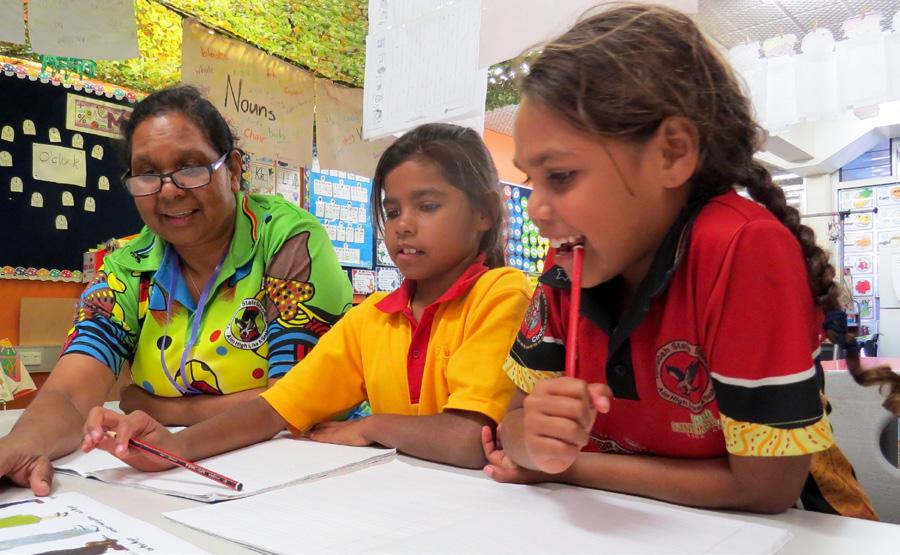 BY CYNDI TEBBEL
BY CYNDI TEBBEL
Opposite: (clockwise from top)
Australian students around the country have joined global climate protests demanding action.
Fifteen-year-old Greta Thunberg, from Sweden, is the face of the global movement, leading student protests and speaking at the UN on the issues.
When the very real possibility of mass global extinction coincides with planning for your future, there is no time to wait for political complacency to reverse the course.
So say millions of students from around the world who have joined the School Strike 4 Climate movement.
The movement began in August last year, when the face of the movement, Greta Thunberg, a stoic 15-year-old Swedish student, began a three-week sit-in at the Swedish parliament. But Thunberg’s direct approach to the climate emergency, which began with #FridaysForFuture, — a weekly agenda of activism — and then School Strike 4 Climate, has engaged more than 1.6 million students in a global campaign of school walkouts.
Prime minister Scott Morrison’s call for “more learning” and “less activism in schools”, at the time of the first strike in last November, motivated Australian student Alicia Guiney to pen what became the movement’s most popular meme: “WE’LL BE LESS ACTIVIST IF YOU’LL BE LESS SHIT”.
Social media is the platform for climate action. Thunberg has 726,000 Twitter followers and counting (that’s 546,000 more than the prime minister).
Victorian high school student Emma Demarchi learned about the movement on Facebook. Demarchi, who is in Year 11 at Swinburne Senior Secondary College in Hawthorn, is a co-organiser of the School Strike
IN SHORT
4 Climate Australia. She became socially aware at a young age, especially about issues of domestic and family violence, but realised the things she cared about really didn’t matter “if we don’t have a healthy planet to live on”.
At the first strike she spoke in front of thousands of fellow students in Melbourne. “That was my first big introduction to climate activism,” she says. “And I haven’t been able to get out of it.”
It’s a sentiment shared by thousands of other students, who’ve committed to a rolling schedule of climate activism. In early December, as part of the #StopAdani alliance protests, students joined First Nation leaders, climate experts and activists to peacefully occupy the foyer of Federal Parliament House in Canberra.
When Adani then announced it would begin work on its mine by Christmas, students were among 15,000 people who took part in snap marches in Brisbane, Melbourne, Sydney and Cairns.
SCHOOL STRIKE 4 CLIMATE AUSTRALIA
School student led and decentralised
National, grassroots, non-partisan movement
DEMAND 1
Stop the Adani coal mine
DEMAND 2
No new coal, oil and gas projects
DEMAND 3
100% renewable energy by 2030
SPRING 2019 // 21 Environment
// The School Strike 4 Climate movement started in Sweden in 2018.
// Australian students have rallied behind the movement.
// A week of global action will take place from 20–27 September 2019.
PHOTOGRAPHY GETTY IMAGES; FAIRFAX SYNDICATION
When you see 40,000 students on the streets, it’s uplifting. It gives you some hope.
Emma Demarchi Year 11 Student, Swinburne Senior Secondary College
By the time of the second School Strike 4 Climate on 16 March this year, Demarchi says she knew the movement had legs. “I’m quite a sceptic, so I’d hoped we’d reach 15,000 people, and we got 40,000.”

Those numbers are testament to the hard work of a core group of organisers in Melbourne, and thousands of grassroots organisers around the country, “and the fact the climate is now a massive issue that people care about,” Demarchi says.
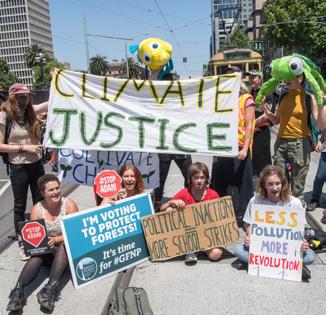
The momentum continued in the lead up to the May federal election, with about 5000 students attending 75 strikes across Australia targeting the offices of MPs, political party headquarters and state parliaments. And on polling day, students were out in force pushing the #VoteClimate message and urging voters to choose politicians committed to stopping Adani, saying no to new fossil fuels and committing to 100 per cent renewables by 2030.
EARTH SHATTERING
The result of the 2019 federal election was a disappointment to those who fought the campaign as a referendum on climate.
But the movement has mobilised young people who might have been apathetic about climate and now care enough to make regular visits to the offices of their local MPs to ensure that climate action doesn’t fade from view.
The strike actions of millions of students are also being noticed by powerful individuals and entities who will be critical to helping the students make headway with their demands.
Nobel Prize-winning economist Joseph E Stiglitz has called the climate emergency “our third world war”. And he urges those who argue it’s too expensive to fight, to wake up. “Our lives and civilization as we know it are at stake,” he says.
Organization of the Petroleum Exporting Countries secretary general Mohammed Barkindo has also taken notice. While denying that oil is the cause of climate change, he recently admitted “a growing mass mobilisation of world opinion against oil” was beginning to influence policies and corporate decision making.
Greta Thunberg tweeted that Barkindo’s admission was “our biggest compliment yet!” It’s proof, she says, “that we are having an impact”.
For Demarchi, activism has become a great way to stay motivated and avoid falling into the ‘OMG everything is doomed trap’.
“When you see 40,000 students on the streets, it’s uplifting. It gives you some hope,” she says.
“And for every bad story you hear, you have to remind yourself of the good work being done. Because there is good work being done.”
The AEU stands in solidarity with students and will work with education departments to ensure students who wish to participate in the 20 September strike and future actions are able to safely participate.
Take action!
September School Strike 4 Climate
Greta Thunberg has announced a week of global action from 20–27 September. It is timed to coincide with a Climate Action Summit in New York on 23 September, hosted by United Nations Secretary-General António Guterres. In Australia, a week of student-led local action will include a nationwide strike on Friday 20 September.
October
Cool Australia’s Enviroweek
This annual week of action will celebrate the achievements of Australian schools from 21–27 October.
It’s an opportunity for students and teachers, from early childhood education to secondary schools, to connect with each other, their local community and environment, and learn how to make positive, sustainable choices. There are resources and opportunities for schools and students to take part at enviroweek.org
22 // SPRING 2019 Environment
Resources Twitter @StrikeClimate Web schoolstrike4climate.com fridaysforfuture.org
PHOTOGRAPHY
SYNDICATION
Cyndi Tebbel is a freelance writer.
FAIRFAX
5 reasons

Why 1.5°C is trade union business

Climate change impacts all workers. Limiting global warming to 1.5°C will make a tangible difference. Here are five reasons why 1.5°C is trade union business!
Union Aid Abroad – APHEDA is the global justice organisation of the Australian union movement. APHEDA works with unions and allies across the Asia-Pacific region for climate justice, energy democracy and a just transition. You can support workers on the front-line of climate change by becoming a member of Union Aid Abroad – APHEDA: www.apheda.org.au/join

CULTURE MATTERS
Aboriginal culture, pride and identity are embedded in all aspects of Briar Road Public School.
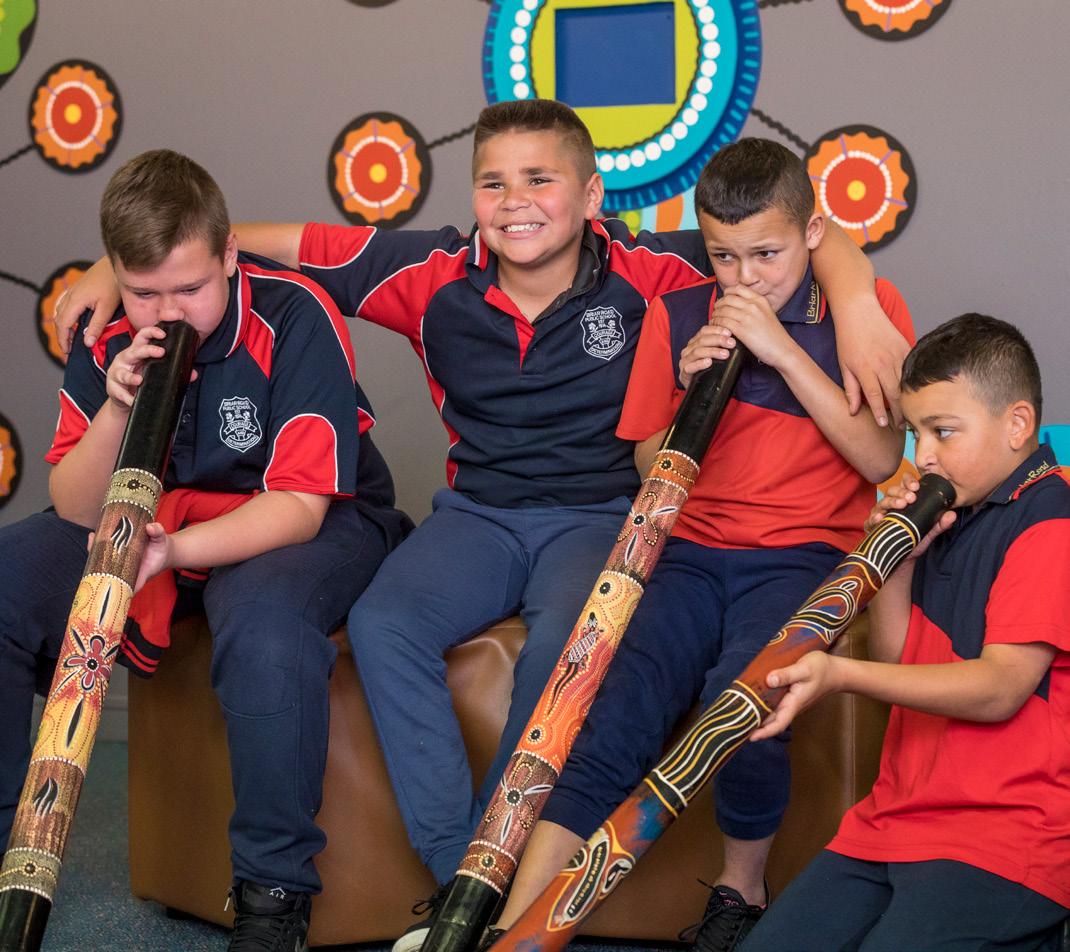 BY KRISTA MOGENSEN PHOTOS GEORGE FETTING
BY KRISTA MOGENSEN PHOTOS GEORGE FETTING
24 // SPRING 2019
IN SHORT
// Aboriginal culture and identity are part of Briar Hill’s framework.
// A third of the school’s students are from non-English speaking backgrounds.
// Initiatives and programs encourage communitywide participation.
Aboriginal students make up about one third of the 290 enrolments at Briar Road Public School in Sydney’s west. Their culture and identity are an essential part of the school’s framework, says principal Tammy Anderson.

“Aboriginal students feel a great sense of pride that their identity and culture is at the forefront of the school,” says Anderson.
“The love and passion for culture, students and the community are evident in the way in which the school functions each day. It’s done great things for reconciliation across the community. The non-Aboriginal community values this just as much as the Aboriginal community.”
Briar Road Public School in NSW is the proud recipient of the 2018 Arthur Hamilton Award.
We identified a range of strategies – not just one – to develop Aboriginal education across the school, from preschool to Year 6.
Tammy
Earlier this year, the school was announced as the winner of the 2018 Arthur Hamilton Award for its outstanding contribution to Aboriginal and Torres Strait Islander education.

A third of the school’s students come from non-English speaking backgrounds and 80 per cent of families are on very low incomes.
SHARED VISION
Anderson says that when she became principal in 2013, the school had a committed group of experienced staff and a shared vision about where it wanted to take Aboriginal education.
“We identified a range of strategies — not just one — to develop Aboriginal education across the school, from preschool to Year 6.”
SPRING 2019 // 25
Arthur Hamilton Award
Anderson Briar Road Public School, NSW
Each term, staff undertake professional development in Aboriginal culture and learning. Teachers can travel to western NSW on a four-day cultural immersion program to learn on country. Other local schools are invited to send teachers too.
“We want to help develop all staff in a culturally authentic way,” says Anderson. Staff also attend the Stronger Smarter Institute for leadership training to support the school’s high expectations for all students.
Community collaboration underpins Briar Road’s progress and successes. “We have a close working relationship with the local Aboriginal community organisation, which provides health and family services support,” says Anderson. “And we work closely with the local Aboriginal Education Consultative Group, which includes a student team that helps us set direction.”
The school’s purpose-built Koori Room is a community hub and cultural resource centre that will soon include a technology-based, self-directed learning space. Nearby, a garden supports the students’ studies into native plants.
“We have conversations with community, and events such as Elders’ luncheons, or dinners where the parents can share a meal with the staff.
“We want to create strong and sustained relationships,” says Anderson. “We invite parents out on excursions — such as bush tucker walks, or to the Dreaming Animals Show at Taronga Zoo — and talk about what we’re doing at school.

“We want to get feedback from parents about how to best support their children.”
LONG-TERM LINKS
Briar Road’s preschool transition program is in its second decade and helps local
26 // SPRING 2019 PHOTOGRAPHY GEORGE FETTING
Principal Tammy Anderson and her team at Briar Road Public School strive to develop a strong working relationship with local Aboriginal community organisations.
Tammy Anderson Briar Road Public School, NSW
We want to meet the vast range of needs for the Aboriginal students and community at our school. And we see that our non-Aboriginal students are benefitting from that as well.
Aboriginal children and their families prepare for the early years of learning.
Aboriginal girls in the school’s ‘Sista Speak’ program visit the preschool and read to the young children, developing friendships and curiosity about starting school the next year. “It’s been a hugely successful initiative,” says Anderson.
The school’s staff provide information to the preschool teachers about the Year 1 curriculum and what students can expect from their first days at school. In turn, the preschool staff help the school with cultural knowledge and how to support Aboriginal learners in the early years, says Anderson. “This gives our kids a great start.”
Other transition programs help students who need extra support to return to school, and Year 6 students to prepare for high school.
Former students stay connected, returning as staff, teachers and mentors. “A former school captain is here now supporting us with a health program

The AEU’s Arthur Hamilton Award was established in honour of Arthur Hamilton, a proud Palawa man, educator and union activist who strove to ensure the right for Aboriginal and Torres Strait Islander students to access a high-quality, appropriate public education.
called ‘Got it’ run by Health NSW,” says Anderson.
Anderson attended Briar Road Public School and attributes her professional success to her own primary education, her time at the local high school and the strong community. “I’ve come home and it’s a wonderful feeling,” she says.
Briar Road Public School aims to achieve and sustain best practice; it invests time each year to reflect on its progress and to identify next steps.
“We want to meet the vast range of needs for the Aboriginal students and community at our school. And we see that our non-Aboriginal students are benefitting from that as well.”
ook ing o on lear n@ me l bour ne s t ar com

AUTUMN 2019 // 27
Arthur Hamilton Award
Tammy Anderson Briar Road Public School, NSW
We have conversations with community, and events such as Elders’ luncheons, or dinners where the parents can share a meal with the staff.
The M e lb our ne St ar is t he onl y gi a nt obse r v at ion w he e l in t he S ou t he r n H e mis p he re Loc at e d in Doc k l a nd s , M e lb our ne ’ s w at e r front pre cinc t , M e lb our ne St ar of fe r s $10 t ic ke t s t o s t ud e nt s a nd com p lime nt ar y t ic ke t s t o t e ac he r s P LU S , com plime nt ar y wor k she e t s a nd ac t i v i t y b ook s t o add t o t he e x pe r ie nce Cont ac t u s t o f ind ou t more or t o m a ke your b
Krista Mogensen is a freelance
writer.
Seasons change
Our new educators continue to learn, grow and expand their skills as they enter the second half of the year.
BY MARGARET PATON
It was a proud moment for new educator Lauren Wells when one of her Year 3 students overcame his fear of speaking in front of others at a public speaking competition in the ACT earlier this year.
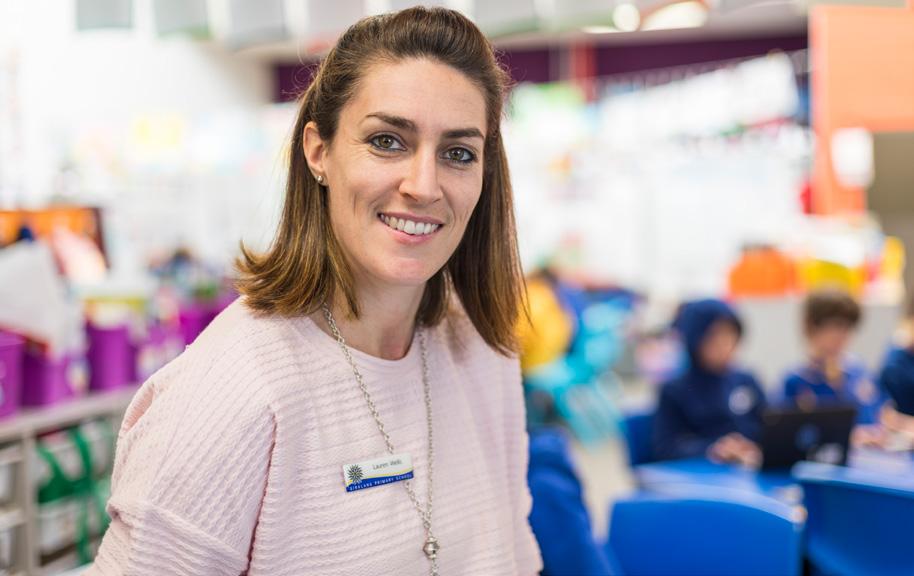
“He didn’t want to do it. He usually shied away from publicly speaking because he found it so daunting,” says Wells.
But she suggested a friend stand with him on stage for support and he agreed.
The result was a success, Wells says.
“He even made eye contact with his audience a few times while he spoke.
“My student was pushed outside his comfort zone and the others were very supportive. You don’t realise how compassionate kids can be. You can’t directly teach those moments.”
Adding to her delight was the fact that all of her 20 students took part in the competition.
Wells has had many proud moments as a teacher and dual Olympian. In March, she took out the 400m hurdles national title for the 12th time.
She puts her athletic success down to remaining positive. It’s an approach she’s carried to her teaching career “because I know that will contribute to me being a better teacher”.
“Being an athlete, my mentality is to achieve the best all the time. But my mentor teacher encourages me to focus on one area of my teaching at a time,” she says.
As a result, she honed her approach to literacy teaching, and set up reading groups and oral language activities earlier this year.
28 // SPRING 2019
PHOTOGRAPHY GEOFF COMFORT
LAUREN WELLS Giralang Primary School, ACT
We follow new teachers throughout the year and feature their challenges and achievements in each issue of Australian Educator

AN INQUIRY PROJECT
Giralang is delving into inquiry-based learning for its students and this is a new concept for Wells. She is encouraging her students to use it to create meaning in their storytelling.
“I’ll try it when we’re reading a book and we’re practising a particular reading strategy. I might ask them what they notice about the page and they all come up with amazing comments – things that I didn’t even think about,” says Wells.
She’s also taking part in an action research project with three colleagues from her teaching team, working with experts from the University of Canberra and other schools. The Teachers as Researchers program asks each school to identify a research project and academics guide the teachers to get the most out of the process.
Giralang’s project is looking at how Aboriginal and Torres Strait Islander perspectives can be incorporated into daily teaching practices.
“It’s about creating a culturally safe school,” says Wells. “We’ll upskill in data collection and analysis, and will become the experts in our school to teach other staff.”
Back in the classroom, Wells is helping her students build their social-emotional skills.
“Getting to know my students, seeing them develop their confidence and resilience, and receiving positive feedback from their parents are highlights for me,” she says.
New Educators SPRING 2019 // 29
Being an athlete, my mentality is to achieve the best all the time.
Lauren Wells Giralang Primary School, ACT
Earlier this year, new educator Christopher Harvey had the rug pulled out from under his feet. Near the end of Term 1, his yearlong contract at Katherine High School was cut short due to a budget shortfall.

Luckily, he was offered a job teaching Humanities at Dripstone Middle School in Darwin. It’s a bigger school, with 500 students, and Harvey is thrilled to have his own classroom.
He is teaching history, civics, citizenship, geography, economics and business to Years 7, 8 and 9 students.
In Term 2, Harvey took over from a teacher who had just retired. It felt a little disconcerting, he says, and students
would sometimes let him know they’d already covered some of the material he was teaching. “Thinking on my feet, I just tell them I want to make sure they really understand it.”
THE POWER OF CROSS-CURRICULA
Harvey is enjoying collaborating with a science teacher for a Year 7 class that looks at water conservation.
“It’s important because my students can do things in their daily lives to help. They’re so engaged, happy and saying they’ve had a great time learning about it.
“It’s the first year the school is trying a cross-curricula approach for all Year 7 classes. It feels really meaningful.”
Behaviour management has become a
key focus for Harvey who says he’s learnt to “hit the ground running”, starting each class with a five-minute activity such as a word puzzle.
“I now have a strategy that’s starting to work: the first warning is verbal about making poor choices; the second warning, the student is moved to a different seat and the third, they go to a buddy class, get detention and a call home.”
Harvey’s professional development agenda has become increasingly busy in the past months. He’s being mentored with another first-year humanities teacher and he’s created an iTunes template to collect and store evidence towards gaining proficiency as a teacher.
He’s also started learning Auslan with two other teachers at the school to help support a student with a hearing impairment whose translator is on extended leave.
It’s a busy workload but Harvey reckons teaching is the best job he’s had in his life.
“Some days really exhaust me but on other days I’ll have those fantastic ‘teachable moments’. I come home and I’m in the best mood.”
30 // SPRING 2019 New Educators
Some days really exhaust me, but on other days I’ll have those fantastic ‘teachable moments’.
CHRISTOPHER HARVEY Katherine High School, NT
Christopher Harvey Katherine High School, NT
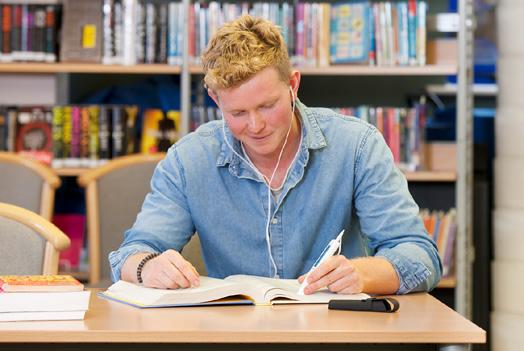
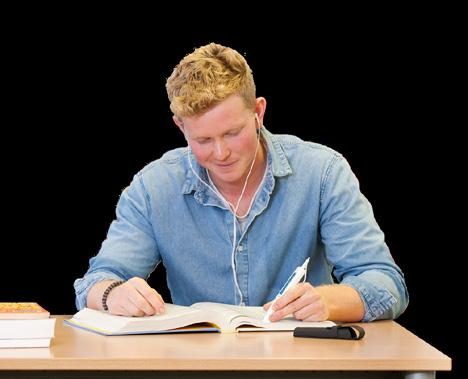







EVERY SCHOOL SHOULD HAVE ONE ESSENTIAL ASSISTIVE TECHNOLOGY FOR 2019 The C-Pen ReaderPen is a vital resource for students with dyslexia and reading difficulties Increase independence & boosts self-confidence Converts text to speech 3GB storage & Voice recorder Allows students to read on their own Now with Australian Accent DAY TRIAL www.readerpen.com AUSTRALIA Promotes independent learning, freeing up valuable teacher time #readerpen Contact: david@scanningpens.com Mob: 0418 800 234 Improves results AWARDS 2019 WINNER MASTERCLASSES - 1 June 2020 CONGRESS & EXPO - 2 - 3 June 2020 SPONSORSHIP + EXHIBITION OPPORTUNITIES STILL AVAILABLE E: education@terrapinn.com P: +61 2 8908 8555 POWERING WORKPLACE L&D REGISTER NOW FOR SUPER EARLY BIRD PRICING $675* *Expires 27 September 2019 / Group discounts apply APPLY DISCOUNT code: “AEEB” www.edutech.net.au
First-year teacher Claudia Sigalla had an “a-ha” moment in her lesson planning – integrate curriculum areas.
“I wish I’d known that at the start of the year. I’ve been progressively rewriting some of my teaching programs from Term 2 onwards and it’s been saving me a lot of time,” says the Reception [Kindergarten] teacher.
INTEGRATION IN ACTION
The penny dropped for her during a visit to her mentor’s class.
“I saw visual arts melded with maths and phonics, all in a semi-structured exploration setting. The kids were constructing something in technology while they were trying to decode words,” says Sigalla.
“I used to look at my program in terms of English, maths, history, health and technology as separate time blocks.”
She had been “struggling” to get through a family history unit, but when she integrated it with collecting data — maths — it came to life.

“The kids started to make connections with maths and their confidence grew and they were sharing that knowledge.”
Since then, she’s been integrating geography into maths and English using the book, Rosie’s Walk by Pat Hutchins.
QUEST FOR RESOURCES
With the planning under control, Sigalla has been on the hunt for resources. She finds inspiration among the 10 or so Reception or Foundation Facebook groups she’s joined.

“They are amazing. We all share ideas and there are thousands of documents on file you can search.
“I’ve been making resources from scratch because I haven’t got a bank of them. For example, I have bought plastic balls that I can write letters on so children can make CVC (consonant-vowelconsonant) words such as cat or dog, for example,” she says.
It all takes a lot of time and Sigalla admits that sometimes she’s still working on preparation for her classes after 10pm.
“It’s really easy to get caught up in trying to make something perfect but, despite the challenges of the workload, I’ve always felt quite well-supported at my school.”
Her busy work life means that outside interests have taken a back seat. “I used to be a semi-professional singer but that’s stopped for now. Although I do sing with my class,” Sigalla says.
Singing helps to engage her class but she uses more formal behaviour management measures, too. A set of classroom rules is on permanent display and Sigalla uses an online community to share each child’s good and off-task behaviours with parents.
“A highlight for me is being really open with parents about their child’s progress. I make myself available in the classroom each morning and afternoon before school to chat with parents,” she says.
All round, it’s been a rewarding year so far for Sigalla. “I’m really enjoying teaching. It’s worth pushing through the challenges and seeing the success of my students’ development over the year,” she says.
New Educators SPRING 2019 // 33
A highlight for me is being really open with parents about their child’s progress.
Claudia Sigalla Settlers Farm Campus, SA
CLAUDIA SIGALLA Settlers Farm Campus, SA
PHOTOGRAPHY PETER FISHER
Margaret Paton is a freelance writer and casual K-12 teacher.
Recognising and rewarding Nominations open for the Arthur Hamilton Award
This is your chance to celebrate AEU members who are making an outstanding contribution to Aboriginal and Torres Strait Islander education.
The Arthur Hamilton Award commemorates the achievements of Arthur Hamilton, a Palawa man who was active in promoting cross-cultural awareness, recognition of Indigenous peoples and the right for Aboriginal and Torres Strait Islander students to access a high-quality public education.
The winner will receive a $1500 prize and be flown to Melbourne to accept the Award at the AEU’s annual Federal Conference in February 2020.

All nominees will receive a certificate from the AEU.
G et nominating!
Download your nomination form at: aeufederal org.au/our-work/indigenous Alternatively, request one from Suzanne Lowndes: (03) 9693 1800 slowndes@aeufederal org.au
Closing date for nominations is Friday 1 November 2019
Find out more
Visit aeufederal.org.au/our-work/indigenous or contact Darcel Russell, Indigenous education o icer: aeu@aeufederal.org.au
The 2018 Arthur Hamilton Award went to the Aboriginal Education Team at Briar Rd Public School.
The Award was presented by Correna Haythorpe, AEU Federal President (centre), to Jessica Scott (left) and Samantha Rangaiya (right) from the Aboriginal Education Team, at the 2019 AEU Federal Conference.
Resources
A new Education International guide provides information and tools for teachers. The publication includes facts on the climate crisis and suggests possible action. It is designed as a practical tool to help educators increase their knowledge and take the lead in their school and communities. Download the guide at tinyurl.com/y2mwfned
CLIMATE CHALLENGES
WHEN VANUATU primary school teacher Neselinda Meta returns to her home island of Ambae, the evidence of climate change is obvious.
“They’ve had to shift the road in the village I come from. When I was a kid, the road was near the sea. Now I’m a mother of two children; the sea has covered the road and a new one has been built,” she says.
Rising sea levels and increasing storms along with volcanic activity — threaten sustainable development in Vanuatu and other Pacific island nations.
In 2015, the most powerful cyclone to hit the Pacific devastated Vanuatu. During Cyclone Pam, 15 people were killed and an estimated 75,000 people lost their homes. Last year, 11,000 people on Ambae Island were evacuated for a second time in less than 12 months when the long-dormant Manaro Voui volcano erupted.
Since then, the government has introduced a national policy to deal with the effects of climate change and natural disaster.
Minister of Climate Change Adaption Ham Lini Vanuaroroa says that while climate change is a major global challenge, the threat is most significant to human security and sustainable development in small island developing states such as Vanuatu. It has a population of about 280,000 across about 80 islands.
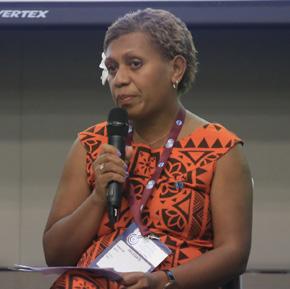
Meta says climate change affects the education system, families and social life. She teaches her students about it, but would like to see a broader community-wide education campaign.
We want to change the world
A WORLD CONGRESS of education unions has set out a determined agenda to fight attacks on quality, free public education, human rights, democracy and the planet.
Almost 1200 delegates representing more than 32 million teachers and education support professionals from 151 countries met in Bangkok in July at Education International’s quadrennial congress. Education International (EI) is the world’s largest organisation of unions of which the AEU is a member.
EI President Susan Hopgood, who is also AEU federal secretary, urged delegates to “carry our commitments home, share them and spread them, and truly make internationalism part of the union movement in every nation”.
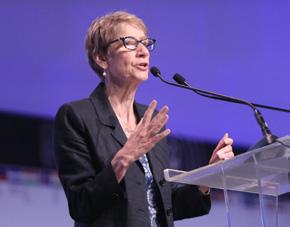
“Our mandate is nothing short of turning the policies and processes of government toward accountable democracy.”
Hopgood says the congress defined a set of goals that could be described simply as: “We want to change the world”.
Primary
school
teacher in Vanuatu
“We need to let everyone know what to expect and what their children will have to face,” she says.
“We’re sometimes quite silent on these issues but we’re becoming victims of climate change. All we want is to have a peaceful life.”
Teacher
“We will promote democracy, human and trade union rights, equity and social justice. We will advance the profession and reassert the vital role of teachers and education support personnel in education and society. We will ensure the right to free quality public education for all. We will take the lead,” she says.
World view
Neselinda Meta
SPRING 2019 // 35
They’ve had to shift the road in the village I come from. When I was a kid, the road was near the sea.
(above)
Neselinda Meta spoke at the 8th Education International World Congress on how rising sea levels impact life and education in Pacific islands.
Susan Hopgood speaking at the EI World Congress.
A worldwide movement to combat the takeover of education systems by commercial interests and bureaucracy now has an Australian focus.
WHAT SHOULD MATTER IN EDUCATION?
BY MARGARET PATON
When Jelmer Evers coauthored The Alternative in 2013, as a reaction against the rise of meaningless performance measures in classrooms and the decline in teacher autonomy, he could have never imagine how far the book would travel.
By the time he co-edited the international follow-up, Flip the System: Changing education from the ground up in 2015, the concept had spread around the world. It attracted support and interest from teachers, researchers, policy makers and international organisations such as the Organisation for Economic Co-operation and Development and Education International, the global federation of education unions.
Evers, a part-time secondary school teacher, writer and activist based in the Netherlands who was twice nominated for the Global Teacher Prize, has since seen country-specific versions of the book published in Sweden, the United Kingdom and now Australia. And there’s a Spanish version in the pipeline.
The good news, says Evers, is that the movement has provided a counter to the “new liberal discourse” that is “anti-education”. For example, he says, we are more aware of the effect of standardised testing on children, teachers, the profession and system.
What’s more, urgent action is needed, thanks to growing economic pressures that threaten the future of education systems through “high-stakes accountability, privatisation and a destructive language of learning”, Evers says. The result is a narrowing of the curriculum and teacher deprofessionalisation on a global scale.
The books argue that neoliberalism is threatening education across the world through high-stakes testing such as the Program for International
36 // SPRING 2019
SUMMER 2018
Student Assessment (PISA), privatisation and commercialisation. And they call for more distributed leadership in education, in which teachers partner with school leaders, administrators and policy makers to positively shape the education landscape.
DIVERSE VOICES
Co-editor Deborah Netolicky says Australia’s contribution to the movement, Flip the system: What matters in education, brings together a diversity of voices with 27 essays by Australian educators.


“It offers a message of hope and alternatives to what’s problematic in teaching — the corporate agenda to overmeasure,” she says. After all, education is a “human endeavour, not a set of metrics”.
We can look to teachers’ expertise to improve the education system, says Netolicky, a Murdoch University researcher and current classroom teacher with two decades’ experience teaching and leading in schools.
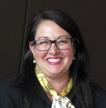

“We are the engine that drives the system. Think of the decisions we make every day, all the micro things we do. There’s a need to trust teachers and their expertise,” she says.
TEACHER UNIONS ON BOARD

Teacher unions, led by the worldwide federation Education International, have embraced the movement, seeing it as vital to bring more attention to professional issues.
It’s a way to build a stronger profession, says Evers, who’s a vice president of the Dutch union AOb.
The AEU has taken an active role in supporting research into the rise of so-called edu-business, the commercialisation of public education. Research commissioned by the NSW Teachers Federation forms the basis for one of the chapters in the book, written by University of Queensland researchers Professor Bob Lingard and Dr Anna Hogan. The study found commercial products were common in Australian public schools, says Hogan. While teachers reported that some products
were useful in developing innovative learning experiences, they cautioned that the private sector should not be allowed to influence what’s taught in schools, she says.
“Teachers felt their professionalism mattered so they should have control over curriculum enactment and the pedagogies that would best suit their particular students and school context.”
More immediately, the bigger question is how much commercialisation is appropriate in public schools.
Hogan points out that significant public funds, sometimes supplemented by parent fees, flow to the private sector to pay for administration support, teaching and learning activities and professional learning.
She says that school leaders and teachers need to become critical consumers of the products and services offered.
THE CONVERSATION CONTINUES
As teachers join around the world to demand an end to the takeover of education systems by big business, the Flip the System books and movement represent the beginning of the conversation, says Netolicky.
“Teachers have been asking: ‘how do we positively influence and shape the system as active agents, not as dehumanised objects having things done to us?’” she says.
Evers, reflecting on where it all began in 2013, says the first book came from discussions he and co-author Rene Kneyber were having about education issues, asking themselves: ‘what are we doing and what’s our role in it?’.
“We thought we’d sell a couple hundred books. But, now, six years later, it’s a global conversation. I’m a bit in awe of what you can achieve with ideas,” Evers says.
Toolkit SPRING 2019 // 37
Margaret Paton is a freelance writer and casual K-12 teacher.
Resources flip-the-system.org Twitter @flipthesystemoz @Jelmerevers
The local book includes 27 essays by Australian educators.
Jon Andrews Co-editor
Deborah Netolicky Co-editor
Cameron Paterson Co-editor
Make it real
BY CYNDI TEBBEL
If Sarah Chapman had her way, children would be introduced to STEM concepts from birth and continue learning about them for at least the next 20 years.
When parents present science, technology, engineering and mathematics concepts using everyday language and activities, children see the subjects as familiar and less abstract. “They become part of the everyday, promoting interest and extension,” says Chapman, who heads the science department at Townsville State High School.
Chapman saw a nascent form of that approach in Finland in 2016 during a visit as part of a global fellowship program, researching best practice in engaging young people in STEM subjects. The Barbara Cail STEM Fellowship was funded by the federal government in partnership with the Chief Executive Women.
NEVER SAY NEVER
Chapman’s enthusiasm for teaching belies her personal history. As the daughter of a primary school principal in country Queensland, she vowed to never enter the profession.

She enjoyed learning though and studied science before completing her honours degree in brain injury research. While working in science and technology event management and communication, Chapman realised she had a gift for explaining things.
She completed her practical teaching at Townsville State High and was offered a job. That was in 2004, when only 15 per cent of the school’s final year students chose a science-related course. Now that figure is 74 per cent. Chapman credits the improvement to a

team passionate about teaching science and years forging connections with local primary schools and STEM industries, working with teachers to boost their confidence in teaching STEM.
She’s enthusiastic about promoting STEM engagement “in whatever capacity or platform I can”. That includes establishing the Townsville STEM Hub in 2014, bringing together
education, business, industry, government and research organisations to demonstrate the benefits of STEM to the broader community.
DIAMONDS IN THE ROUGH
Chapman says her most rewarding moments are those in the classroom. She describes students as “diamonds in the rough”. She says observing them get excited about what they’re learning “is a true privilege”.
“One of my former students recently started first-year medicine,” says Chapman. “I still remember her dissecting a rat in Year 9 and looking at me at the end of the lesson saying ‘This is what I want to do. I want to become a doctor’.”
Another student, an Aboriginal and Torres Strait Islander boy, was troubled by the number of people in his family with diabetes. Chapman arranged for him to attend a STEM camp and explore a range of STEM projects about natural medicine. He’s now in his second year at university studying science and hoping to go into medical research.
“Things like that are priceless to me. If I influence one student that will save or influence the lives of many, that’s the most important thing about being a teacher,” says Chapman.
Why do you teach?
We’d love to hear your best tips for engaging young minds. Email us at educator@hardiegrant.com if you have something to share. You can provide a written piece or we’d be happy to interview you.
Recess 38 // SPRING 2019
A child’s journey with STEM (science, technology, engineering and maths) subjects should begin before they start school.
Cyndi Tebbel is a freelance writer.
Sarah Chapman Townsville State High School
I still remember her dissecting a rat in Year 9 and looking at me at the end of the lesson saying ‘This is what I want to do. I want to become a doctor’.











#Terms & Conditions apply, for full details visit smartleasing.com.au/wish-you-were-here-terms. Promotion period is 01.07.19 at 00:01am – 20.09.19 at 11:59pm. Joint promoters are: Smartsalary Pty Ltd (Smartleasing is a registered trademark of Smartsalary), AccessPay Pty Ltd, Salary Packaging Solutions Pty Ltd, Selectus Pty Ltd and Autopia Management Pty Ltd. The prize pool is shared among the five named joint promoters. This means, for example, that an eligible entrant who is a customer of Smartsalary will be competing for one (1) Grand Prize holiday with all other eligible entrants, who may be customers of any other of the joint promoters. The shared prize pool consists of (a) one holiday to the Maldives, (b) twelve $500 eGift Cards and (c) sixty $100 BP Fuel Cards. Permit numbers: ACT TP 19/03575, NSW LTPS/19/35561, SA. Licence No: T19/975. *Based on the following assumptions: living in NSW 2560, salary: $70,000 gross p.a., travelling 15,000 kms p.a., lease term: 60 months, using the Employee Contribution Method for FBT purposes. Images shown may not be the exact car that the calculations have been based on. All figures quoted include budgets for finance, fuel, servicing, tyres, maintenance, Vero by Suncorp comprehensive motor insurance, Hydro Platinum Pack and re-registration over the period of the lease. Also includes, for Suzuki, Audi and BMW models only, 2 year Platinum Warranty insurance. Vehicle residual, as set by Australian Taxation Office, payable at the end of lease term. The exact residual amount will be specified in your vehicle quote. Vehicle pricing is correct at the time of distribution but may be subject to change based on availability. Mitsubishi ASX ES ADAS $ 353* PER FORTNIGHT INC. $152 OF RUNNING COSTS Request a quote on a car you love to see how much you could save! Looking for a different car? Salary package your next car for your chance to WIN! WIN a holiday to the MALDIVES! Plus, daily and weekly prizes up for grabs. Quoted prices include: Finance Rego CTP Fuel Maintenance Insurance Flexible eGift Card $500 Mazda CX-5 Maxx Auto FWD $ 392* PER FORTNIGHT INC. $149 OF RUNNING COSTS Toyota RAV4 GX Hybrid $ 453* PER FORTNIGHT INC. $140 OF RUNNING COSTS $ 550 PER FORTNIGHT INC. $161 OF RUNNING COSTS Nissan Navara ST-X DC 4x4 Auto Find out how much you can save with a novated car lease. 1300 156 497 | teachersleasing.com.au Audi A3 Hatch 1.0T $ 444* PER FORTNIGHT INC. $145 OF RUNNING COSTS

Product issued by the QSuper Board (ABN 32 125 059 006, AFSL 489650) as trustee for QSuper (ABN 60 905 115 063). Consider the PDS on our website to see whether QSuper is right for you. © QSuper Board 2019. Welcome to super without surprises Looking after members’ retirement savings since 1912.

































 BY KRISTA MOGENSEN
BY KRISTA MOGENSEN





 BY CYNDI TEBBEL
BY CYNDI TEBBEL





 BY KRISTA MOGENSEN PHOTOS GEORGE FETTING
BY KRISTA MOGENSEN PHOTOS GEORGE FETTING





































